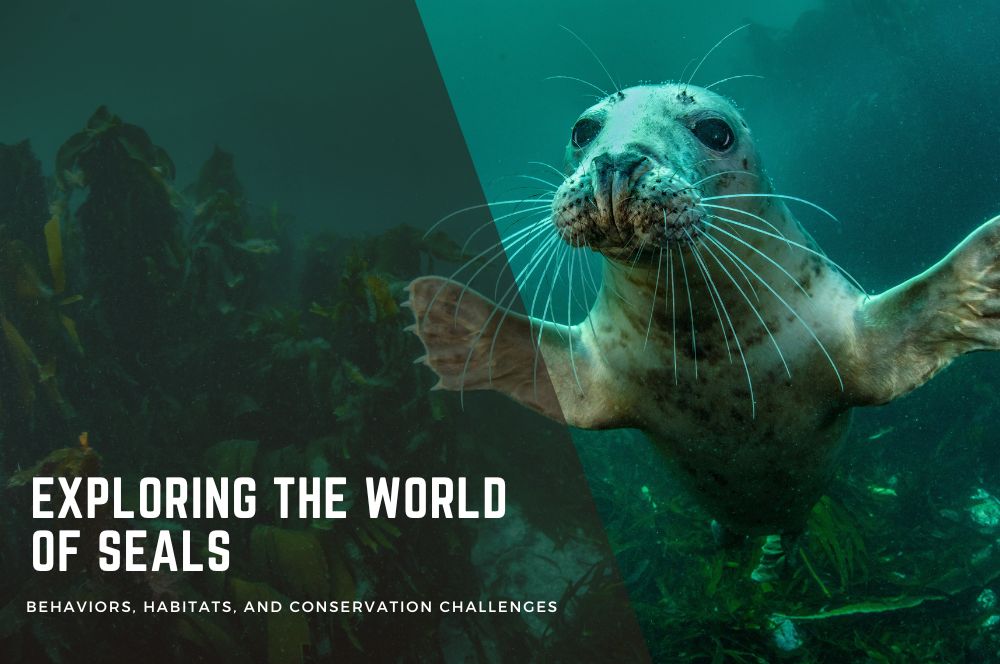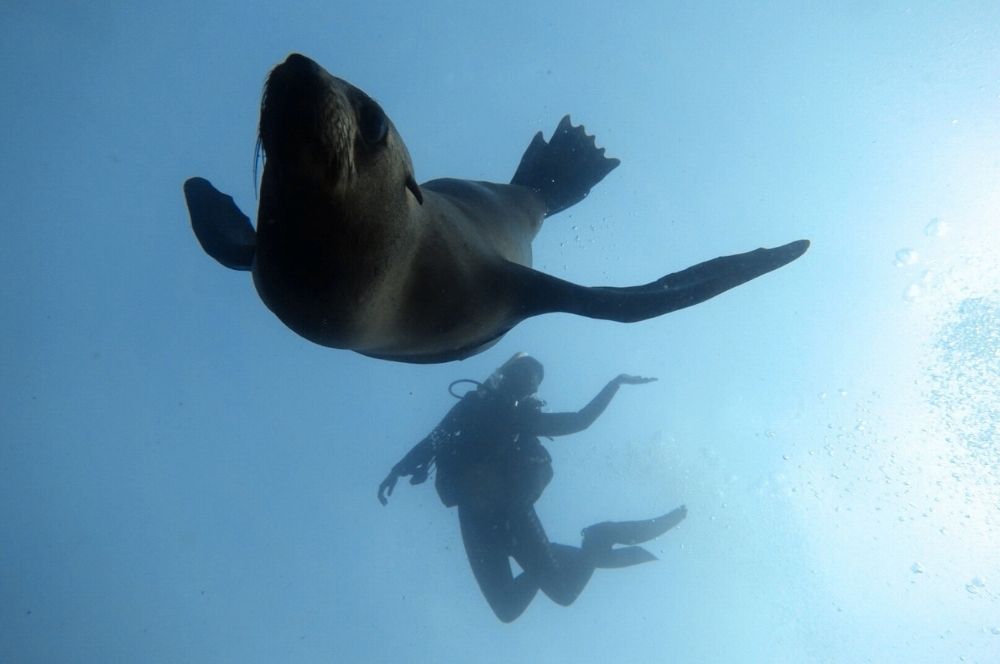You have 0 product(s) in your cart.
Abyss Scuba Diving
Exploring The World Of Seals: Behaviors, Habitats, And Conservation

Exploring the World of Seals: Behaviors, Habitats, and Conservation Challenges
Seals captivate us with their playful nature and impressive adaptations for life at sea. But behind their charismatic appearance lies a struggle for survival. In this concise guide, we uncover where seals thrive, shed light on their predatory prowess, complex behaviors, and frame the conservation efforts crucial to their existence.
Key Takeaways
-
Seals, or pinnipeds, have adapted to a variety of habitats, including Arctic ice and freshwater lakes, and possess diverse physical adaptations such as streamlined bodies and powerful flippers for thriving in marine environments.
-
Pinnipeds face nutritional challenges due to entanglement in fishing gear, competition with fisheries, and intentional harm by fishermen, in addition to demonstrating a range of complex social behaviors and mating systems for survival and reproduction.
-
Seal conservation is critical as climate change, and human activities pose significant threats to their habitats and populations, with efforts needed to address the melting of sea ice, entanglement in debris, and the hunting pressures on endangered species like the Hawaiian and Mediterranean monk seals.
Diving into the Depths: Seals in Their Natural Habitat

Seals, often referred to as pinnipeds, inhabit a broad range of environments. Whether it’s the frigid Arctic waters, where seals rely on ice for breeding or the freshwater environment of Siberia’s Lake Baikal, home to the intriguing Baikal seal. These aquatic mammals have adapted to thrive in their respective habitats.
Pinniped Habitats
While seals are known to inhabit diverse environments, they generally favour cool, nutrient-rich waters with temperatures lower than 20 °C. This temperature range offers optimal conditions for seals, providing an abundant food supply and suitable breeding grounds.
Among these marine-dwelling seals, including the harbour seal, a unique species, the Baikal seal, stands out. This pinniped thrives in the freshwater environment of Siberia’s Lake Baikal, a testament to seals’ adaptive capabilities.
Adaptations to Marine Life
Seals have evolved from land-dwelling musteloid ancestors into aquatic animals, developing sleek, torpedo-shaped bodies and powerful flippers. Their streamlined bodies, small or non-existent ear flaps, and flexible necks contribute to their marine adaptation. For diving, seals have developed the ability to exhale much air, close their nostrils, collapse their lungs, and store air in their bronchioles and trachea.
While swimming, eared seals use their front flippers in a rowing motion, and true seals use a side-to-side stroke with their hind limbs.
Social Structures and Behaviors
Interactions among seals are as fascinating as their adaptations. Pinniped mating systems vary, with some species practicing extreme polygyny where a single male mates with multiple females, and others demonstrating serial monogamy. Sexual dimorphism is prevalent in pinnipeds, with males often evolving to be considerably larger in size compared to females. This size difference has implications for their mating strategies.
During mating season, male seals become highly competitive, aggressively fighting to establish dominance, and set up territories onshore where they remain without eating for the duration. An interesting example is the California sea lion, a social species known for their loud barks which play a significant role in their group communication.
The Seal Diet: From Fish to Squid

Seals are carnivorous by nature, relying on a diet composed mainly of fish caught in the sea. However, their food palette extends beyond fish to include other marine life such as squid, mollusks, and crustaceans. There are also specialist diets among seals, such as the krill-eating crabeater seals and crustacean-eating ringed seals.
Predatory Techniques
In the sea, seals display impressive predatory techniques. The leopard seal, for instance, hunts for prey by snagging birds with their canines and thrashing them against the water’s surface to capture them. This strategy allows the leopard seal to efficiently procure its food.
Feeding Challenges
Despite their predatory prowess, seals often face challenges when it comes to feeding. They can become entangled in fishing gear, which can impede their ability to hunt and lead to starvation or serious injuries. Entanglement in fishing lines and nets is a significant threat, causing physical restrictions and sometimes death, directly influencing their feeding success.
Moreover, competition with commercial fisheries for prey species can drastically reduce the availability of food for seals, challenging their feeding habits. In some cases, fishermen may intentionally kill seals, viewing them as competition for fish stocks, which can have a detrimental effect on the feeding opportunities for the seal population.
The Playful Pinnipeds: Scuba Diving with Seals

Beyond their natural habitats and behaviors, seals offer humans a unique recreational opportunity - Scuba Diving. This activity offers an incredibly fun and rewarding experience, giving participants a chance to interact with these marine mammals in their natural environment.
Maximizing the Experience
To maximize the diving experience, it is important to follow guidelines and maintain a respectful distance from the seals. Interaction with seals should be initiated by the animals themselves to avoid prompting aggressive behavior. Divers should not follow seals into narrow spaces, should respect their space by not blocking escape routes, and must be mindful of seals’ behavior and body language.
For those who have not participated in dives for over a year, it’s recommended to do a refresher on scuba diving skills before diving with seals to ensure both safety and enjoyment.
Seal Encounters Around the World
Seal encounters are not limited to a single location. There are various global hotspots for seal encounters, including Montague Island in Australia and Cape Town in South Africa, where the seals are playful and divers can experience remarkable underwater encounters.
At Montague Island, Australia, divers can enjoy the company of Australian and New Zealand fur seal pups throughout the year, especially from June to September as they migrate southward, offering an unforgettable experience with visibility extending from 10 to over 40 meters.
In Cape Town, South Africa, diving with the cape fur seal is a must at spots like Duiker Island, Partridge Point, and Strawberry Rock, where seal pups are particularly active between September and May.
Conservation Concerns and Efforts

While seals, including earless seals and fur seals, are fascinating creatures, they also face considerable conservation challenges alongside polar bears. The melting of sea ice due to climate change is recognized as the single largest threat to many pinniped species, compromising their essential resting and breeding areas.
Ringed seals, for example, rely on snow-covered ice floes for pup rearing and protection from predators, with predictions indicating a potential 50% population decline by 2100 without sufficient snow cover.
The Plight of Endangered Species
The Hawaiian monk seal, the Mediterranean monk seal, and the Caribbean monk seal are all among the world’s most endangered seal species. They are all pinnipeds. The Mediterranean monk seal faces several threats, including adverse human interactions, the loss of their coastal cave habitats, and becoming entangled in fishing gear.
Similarly, Hawaiian monk seals are endangered. Their survival is challenged by:
-
Limitations in food supply
-
Entanglement in debris and fishing gear
-
The introduction of new predators such as sharks
-
Habitat loss
Human Impact and Protective Actions
Historically, seals have been hunted by humans for various uses, including:
-
Their pelts, which were used for clothing
-
Their fat, which was used for lamp fuel and cooking oil
-
Their organs, which were used for early insulin production
Commercial hunting for meat, hides, oil, and fur has adversely impacted the feeding habits of seals and their overall populations.
Seal hunting has influenced the economies and subsistence of certain communities but has faced regulation and controversy due to conservation and animal welfare concerns.
Seals in Culture and Mythology

Seals hold a significant place in culture and mythology, symbolizing wisdom, intellect, and imagination in various cultures. In Scottish and Irish folklore, seals are often depicted as mystical shape-shifters known as selchies or selkies, who can transform from their seal form into human shape on land.
Symbolism and Significance
Symbolically, seals are revered as:
-
Keepers of wisdom, embodying the connection between intellect and imagination
-
Teachers of being at ease with oneself and valuing one’s surroundings in Indigenous Australian culture
-
Symbols of authority and assurance in various cultures
-
Used in document sealing, such as the Treaty of Paris in the US.
Seals and Human History
Seals and humans have had a long history of interaction, from hunting for survival to their use in sealing documents. Seal hunting, also known as sealing, is a practice with at least a 4,000-year history, with various methods like:
-
clubs
-
spears
-
harpoons
-
nets
-
firearms
The Inuit have historically relied on seals for essential needs like food, clothing, and tools, while sealing became a major industry in certain regions like Newfoundland, Labrador, and the South Atlantic.
Seals also have a place in history as symbols of authority and authenticity, reflected through the use of wax seals by nobles, clergy, and rulers during the Middle Ages.
Seals Across the Globe: Species Spotlight
Seals across the globe exhibit unique characteristics and noteworthy populations. Some of the most recognizable species of seals include:
-
The crabeater seal
-
The leopard seal
-
The northern elephant seal
-
The southern elephant seal
The Baikal seal is unique among seals as it lives in a landlocked lake in the middle of Asia, demonstrating the wide range of environments these animals can inhabit.
Unique Characteristics
Pinnipeds possess distinct features that set them apart from other marine animals. Here are some of their distinguishing characteristics:
-
Otariids, such as sea lions, have visible ear flaps known as pinnae.
-
Seals have small holes instead of external ears.
-
Walruses have prominent, elongated tusks and the ability to curl back flippers under their body to walk on all fours.
Male northern elephant seals develop an inflatable proboscis for vocal threats during breeding sessions and have thick calloused skin on their necks as a protective shield during fights.
Noteworthy Populations
Among the various seal species, northern elephant seals are notable for their extensive migratory behaviour, covering vast distances in the ocean. These seals migrate as far west as Japan and as far north as Alaska from their breeding grounds to forage, demonstrating the significant range of their habitat utilisation.
Other notable populations include seals and sea lions, such as the New Zealand sea lion, which has been recorded to dive to depths of up to 460 meters, showcasing the impressive adaptations of this species.
Summary
In this exploration of the world of seals, we’ve delved into their diverse habitats, unique adaptations, and complex social structures. We’ve also highlighted the challenges they face due to climate change and human activities, and the conservation efforts in place to protect them. Seals, these captivating creatures of the sea, continue to intrigue us with their resilience, intelligence, and playful demeanor, serving as an enduring symbol of the wonders of the marine world.
Frequently Asked Questions
What is the primary diet of seals?
Seals primarily rely on a diet composed largely of fish, squid, and other marine life for their carnivorous needs.
What are some threats to seals?
Seals are threatened by climate change, entanglement in fishing gear, competition with commercial fisheries, and intentional killing by fishermen. These factors pose significant risks to their survival.
Where can I scuba dive with seals?
You can scuba dive with seals at Montague Island in Australia and Cape Town in South Africa, where you can interact with these marine mammals in their natural habitat.
What are some endangered seal species?
The Hawaiian monk seal and the Mediterranean monk seal are two of the world's most endangered seal species. It's crucial to focus on their conservation efforts to ensure their survival.
What makes the Baikal seal unique?
The Baikal seal is unique because it is the only seal species that lives in a landlocked lake, which is located in the middle of Asia.
Recent Posts






